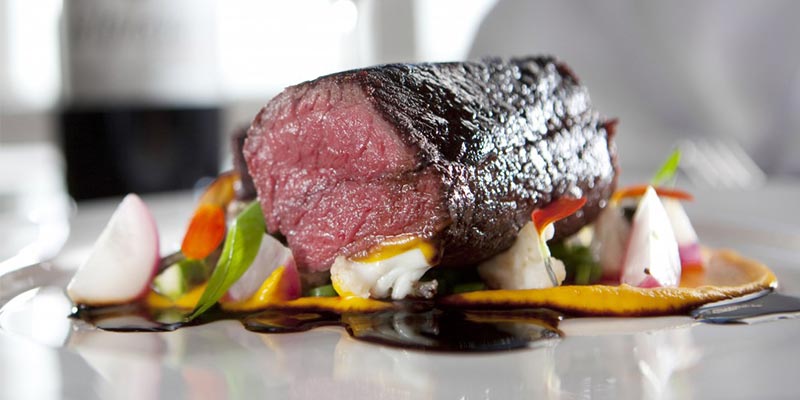5 Mouthwatering Trends in Nordic Cuisine
By Pam Morton
Senior Manager, Digital Marketing
Virtuoso
Some years ago I asked a bartender in a Helsinki hotel bar his definition of a typical Finnish drink. He said, “Anything with vodka!” But another patron chimed in with his favorite twist: a recipe for vodka with cloudberry liqueur.
The next day I went to the outdoor market and bought cloudberries. I discovered the delicious taste of raspberry crossed with red currant. I was officially hooked on Nordic cuisine. And adventurous travelers to the Nordic countries will be too.
As you travel the Scandinavian countries, ranging from Iceland across the map to Finland, take advantage of these 5 hot trends in Nordic cuisine.
Nordic Cuisine Trend #1: Global Fusion
Marcus Samuelsson is the face of global fusion in the Nordic cuisine world. Adopted from Ethiopia by Swedish parents, at 24 the executive chef of Aquavit restaurant in Manhattan was the youngest ever to receive a 3-star review from the New York Times. At his Manhattan restaurant Kitchen & Table, he created “fun dining” instead of “fine dining.” He achieved this by using local raw materials and creating an ambience that nurtures a mix of people and lifestyles.
Catering to travelers, Samuelsson’s new restaurant (also called Kitchen & Table) is at the Arlanda airport in Stockholm. Menu items include Manhattan favorites, as well as smoked salmon with salmon caviar, grilled asparagus with pickled chanterelles and charcuteries with cloudberry relish. Where better to experience global/Nordic cuisine than in an airport?

Tapping into traditional methods of preserving food is part of today’s Nordic cuisine
Nordic Cuisine Trend #2: Connection to Local Culture
The hottest new Nordic chef on the global scene is Magnus Nilsson, chef of Fäviken restaurant in far north Järpen, Sweden. Not content with revolutionizing Nordic fine dining, he recently published The Nordic Cook Book. It’s filled with 750 pages of recipes for home cooks. To research the book, he traveled across the Scandinavian countries to uncover the best of home cooking, past and present.
To Nilsson, food culture is a way of life. Knowledge about growing, gathering, preserving and preparing food is passed from generation to generation. In the Far North, this means making the best use of ingredients at hand. One example: the Icelandic preparation of quail eggs covered with volcanic ash and baked. Nilsson adapts this by using smokehouse ash instead of volcanic. Food expresses the way Nordic peoples have sustained and celebrated life in a harsh climate. Experiencing local food enhances your trip, even if you pass on the ash-covered quail eggs!
Nordic Cuisine Trend #3: Transfer of Food Knowledge
Reflecting global trends, Nordic chefs are turning to the past. They’re incorporating traditional ingredients and techniques in their cuisine. Although gardens flourish for six months of the year in the Nordic countries, importing fruits and vegetables is expensive, and the quality of the produce suffers. Chefs are consulting old cookbooks and their grandmothers about traditional means of preserving vegetables. The result is a revival of root cellar vegetables, dried fruits and pickled vegetables of all kinds.
In a Netflix Chef’s Table documentary, Nilsson states that oral information about home cooking is passed on reliably for one generation. Then there’s some loss of reliability in the second and third generations. In his Fäviken kitchen he consciously transmits his knowledge of traditional cuisine to diners and employees.
What does this transfer of food knowledge mean for you as a traveler? New and interesting ingredients, prepared in ways that aren’t fussy or over the top. What could be more basic than a reindeer filet? Look at it as a Nordic version of prime rib.

Reindeer filet is exotic to most of us, but to Scandinavians, it’s as savored as prime rib
Nordic Cuisine Trend #4: Fresh Preparation
At Fäviken, scallops are cooked over burning juniper and birch, a perfect example of fresh ingredients. They’re prepared quickly and without fuss. Scallops with their natural broth are placed in their shells without salt, pepper or spices. They’re grilled for a few moments and served immediately. Diners at Fäviken describe the flavors as “intense” and “bright”.
Because the cold climate acts as a natural pesticide, and there’s plentiful grazing for animals, much of the meat and produce is organically grown. As you travel in the Nordic countries, you’ll experience the enhanced taste of freshly prepared, locally grown food. To get the most from their food resources, chefs use fresh, local food. It simply tastes better.
Nordic Cuisine Trend #5: Exotic Ingredients from Hunting, Fishing and Foraging
The harsh climate of the Nordic countries required past generations to get food any way they could. Their methods included hunting, fishing and foraging. Wild game are abundant: puffins, moose, deer, grouse and ptarmigan. Nordic cuisine makes use of exotic marine life species such as whale, seals, zander and shark. Fish are prepared fresh, salted, dried and fermented. Modern Nordic chefs are adapting these exotic ingredients to current culinary tastes.
Throughout the Nordic countries, people have a traditional right to forage from the land. Laws vary by country, and in Sweden the right to forage applies to parks and private property. From spring to fall the forests provide berries, chanterelles, porcini and edible flowers.
How You Can Experience These Nordic Cuisine Trends Firsthand
Whether you try traditional smörgåsbord, sample Nordic fusion cuisine or the more exotic offerings of the Far North, adventurous travelers and dedicated foodies will find diverse and delicious ways of experiencing travel to the Nordic countries. Your Virtuoso advisor can help you plan a food-focused journey there. And because they have the right connections, you might even find yourself at the hottest restaurant of the moment. Or visiting a market with a chef. Or capping off your Nordic dining adventures with vodka – or cloudberry liqueur.
The post 5 Mouthwatering Trends in Nordic Cuisine appeared first on Virtuoso Luxury Traveler.


